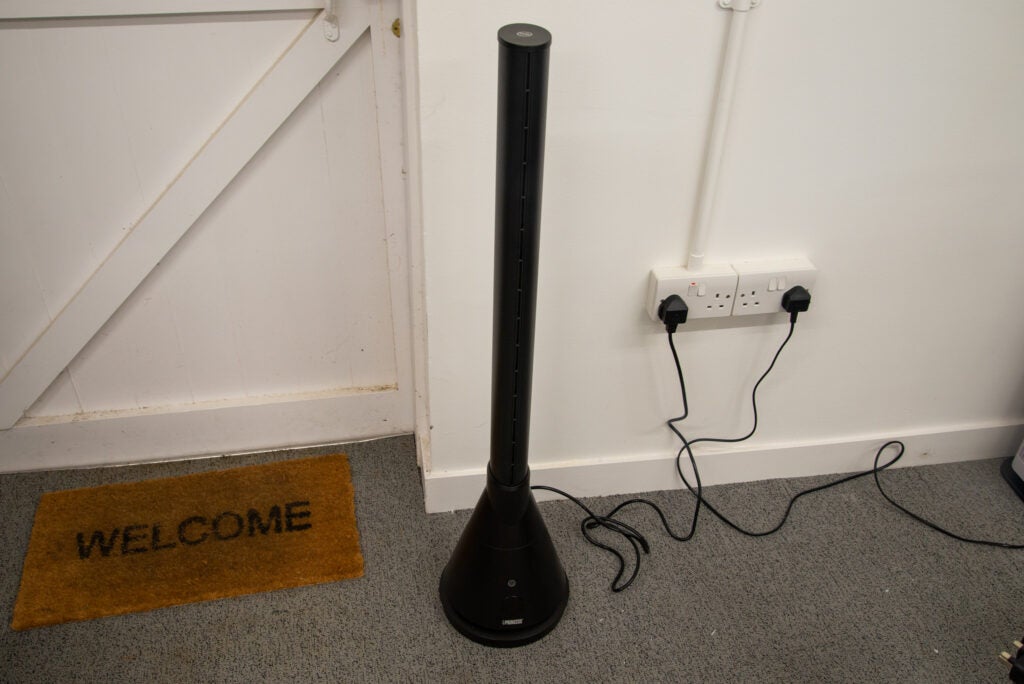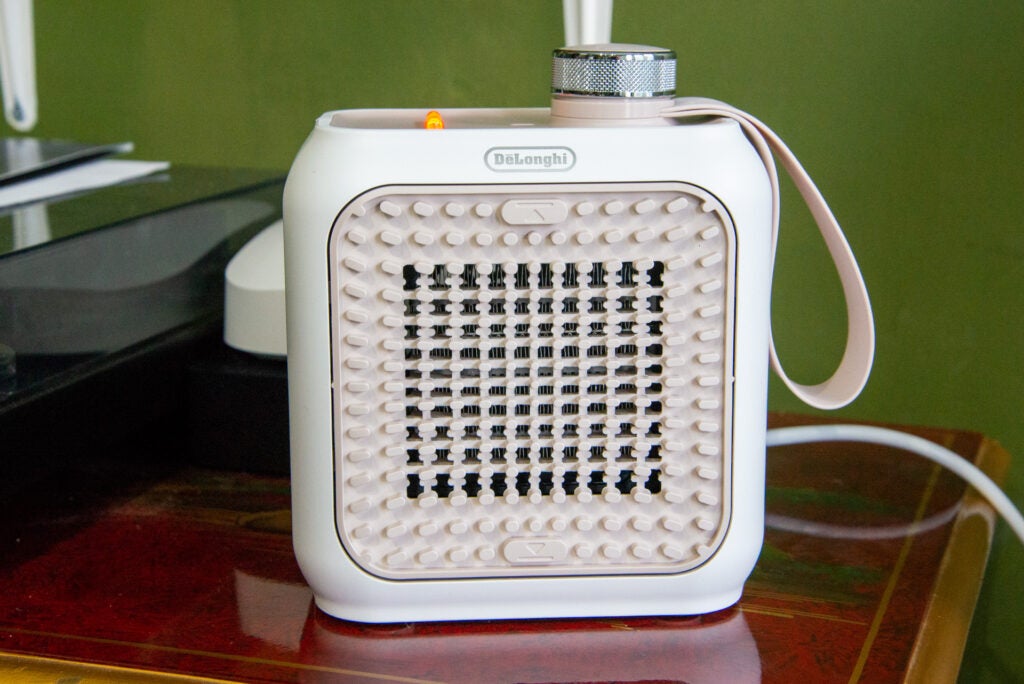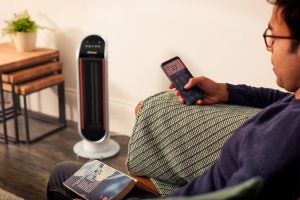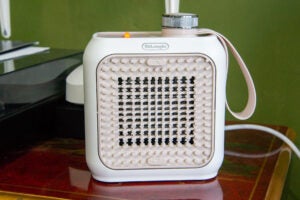Best Electric Heaters 2024: Keep warm with our pick of the best

If you need some extra help to warm up your home over the harsh winter months, then this list of the best electric heaters could come in very handy indeed.
Electric heaters are versatile bits of kit: they can help add warmth to a room that already has a radiator, they can be used to heat just one room without having to turn the main heating on, plus they can be used anywhere there’s a plug, such as in an outbuilding.
With the cost of electricity at an all-time high, buying an electric heater may not sound like a great idea. A typical 1,800W heater, for example, may cost 61p an hour to run, which might sound terrifying. However, don’t let that necessarily put you off.
Electric heaters are generally fast at warming up a limited area, that is, putting out a lot of heat in a short space of time. This means they don’t have to be on for long to make a noticeable difference, and if you buy a heater with a thermostat then it will shut down once your room has reached the right temperature.
Don’t let the power rating put you off, either. As it’s easy to turn electricity into heat, all electric heaters are roughly as efficient as each other. The main difference between different powered models is how much heat they can put out at once: a high-power heater will warm a room faster than a lower-powered one, but their overall power usage will be similar.
That said, very low-power heaters are good for warming just yourself: making a cold working space more comfortable, for example. Also, you should buy a heater that’s big enough to warm your room, as every heater will tell you the maximum-sized room it will work in.
The downside to electric heaters is that the warmth they produce will be lost quickly (radiators cool down slowly, so rooms cool more slowly as a result), and they can struggle to fill up larger rooms. As such, they’re better suited for small to medium-sized rooms, or for use with existing heating.
Here, we’ve rounded up the best electric heaters, having reviewed all types of models: fan heaters, convection heaters and oil radiators.
All use electricity, so efficiency remains the same across all models. The main differences come in the way that they work.
Best electric heaters at a glance
- Great all year round: Dyson Purifier Hot+Cool Formaldehyde – check price
- Smart heater & cooling fan: Princess Smart Heating and Cooling Tower – check price
- Powerful heat & fan modes: Dimplex MaxAir – check price
- Best personal heater: De’Longhi Capsule Desk – check price
- Best mini smart heater: Dreo Atom 316 – check price
- Well-priced for smaller rooms: Devola Smart WiFi Platinum 1.5kW Glass Panel Heater – check price
- Best for flexibility: De’Longhi Capsule Fit Fan Heater – check price
- Most stylish heater: Aeno Premium Eco LED Smart Heater – check price
How we test
It’s important that we test all electric heaters in the same way. We measure how hot they get (or the heat output from a fan heater). We measure how fast the air moves out of each heater, which is especially important for fan heaters, where they’re designed to push air into the room. We also measure the temperature of our test lab, seeing the effect that each heater has. We measure electricity consumption on the highest and lowest settings, so we can gauge how much each product will cost to run. Finally, we test any smart features and apps that a heater may have.
- Works all year round
- Powerful purification
- Excellent smart controls
- Expensive
- Powerful heating and cooling
- Useful smart app and voice control
- Doesn’t take up much space
- Doesn’t display fan mode on LCD
- Could do with a lower fan speed
- Super-strong fan
- Incredibly effective heating
- Three-year warranty
- Expensive
- Quite noisy
- Cheap to run
- Compact
- Gentle individual heat
- Thermostat not that useful
- Tiny and very portable
- Effective heating
- Doesn’t look or feel cheap
- Controls could be improved
- Good value
- Remote control, touch controls and smart app
- Heats fast
- App doesn’t have a timer setting
- Looks great
- Powerful
- Three heat settings
- Basic thermostat
- Fan-only mode not that useful
- Excellent heat output
- Brilliant design
- Wall, floor or ceiling mount options
- Physical controls hard to reach in some mounting positions
- Gets very hot

Dyson Purifier Hot+Cool Formaldehyde
The best overall heater
Pros
- Works all year round
- Powerful purification
- Excellent smart controls
Cons
- Expensive
If you don’t want to buy another appliance that sits there being useless for half the year or more, the Dyson Purifier Hot+Cool Formaldehyde may be for you. This is a traditional fan, a fan heater and a purifier all-in-one. At the bottom of the fan sits the filter, which can capture fine particles and gases. These filters should last for about a year, although the app and display will tell you when it’s time to make the change.
Dyson’s app is one of the best. From here, you can control every aspect of the fan, including enabling the heat mode, setting a target temperature and even scheduling when you want it to turn on and off. In this way, the Purifier Hot+Cool Formaldehyde acts much like a smart thermostat.
It warms a room quickly, but it’s also exceptionally quiet, running at 39.62dB (background noise) on its lowest setting. On full pelt in fan mode, I measured it at 3.8m/s – fast enough to provide cooling, with Dyson’s fanless design delivering smooth air.
Air purification is equally as good, and the range of sensors this model has means that it responds to lots of atmospheric contaminants quickly and efficiently. Perfect for use at any time of year, this is a brilliant all-round product, but it is expensive.
Review: Dyson Purifier Hot+Cool Formaldehyde
Reviewer: David Ludlow

Princess Smart Heating and Cooling Tower
The best hot and cool fan
Pros
- Powerful heating and cooling
- Useful smart app and voice control
- Doesn’t take up much space
Cons
- Doesn’t display fan mode on LCD
- Could do with a lower fan speed
It doesn’t have a built-in air purifier, but as the Princess Smart Heating and Cooling Tower has both heating and cooling modes, it’s still useful for most of the year. You can control all of the features and set the fan speed and target temperature using the bundled remote control, but you get a few more options if you connect the fan to your Wi-Fi network.
Via the Climate app, you get all of the same options that the remote control gives, plus you can set a timer and schedule when you want the fan to become active. That’s very useful if you want to regularly heat a space and need smart thermostat-like controls. There are a few mismatches between what’s on the fan and what’s replicated in the app, but these are minor annoyances at worst.
In fan mode, the Princess Smart Heating and Cooling Tower is as powerful as its Dyson rival, although quite a bit louder – particularly as the lowest fan speed isn’t that low. Heat mode was enough to cope with a 30m2 test lab, getting it to a comfortable 21°C before the fan shut down.
Having an accurate thermostat is very helpful on a product such as this, as it means you’re only using a high amount of electricity (1983kW here) for a shorter period. Heaters with inaccurate thermostats will typically run for longer than you need them to run.
Well-priced and useful throughout the year, the Princess Smart Heating and Cooling Tower is a great option for anyone who wants a smart device with a high level of control.
Review: Princess Smart Heating and Cooling Tower
Reviewer: David Ludlow

De’Longhi Capsule Desk
The best personal heater
Pros
- Cheap to run
- Compact
- Gentle individual heat
Cons
- Thermostat not that useful
Drawing just 352W, as read from our power meter, the De’Longhi Capsule Desk costs only 12p per hour to run. The reason it doesn’t use much power is because it’s a small electric heater – no bigger than a DAB radio – designed to warm one person at a time.
Drop this on a desk and angle its grille, and the De’Longhi Capsule Desk can push out an envelope of warm air. We found that it made it much more comfortable to sit in a drafty office, making us feel warmer and, crucially, keeping our hands warm.
The controls on this device are very simple: there’s a single dial on top that you twist to adjust the unmarked thermostat. We don’t think that the thermostat is that helpful here, as we tended to set this heater to maximum and turn it off once we felt warm, rather than letting it click off automatically.
This heater doesn’t have the power to affect the temperature of an entire room, but if you want a relatively cheap way to keep yourself warm, it’s a great choice.
Review: De’Longhi Capsule Desk review
Reviewer: David Ludlow

Dimplex MaxAir
The most powerful heater
Pros
- Super-strong fan
- Incredibly effective heating
- Three-year warranty
Cons
- Expensive
- Quite noisy
The Dimplex MaxAir is a full-on tower fan, producing enough cooling air to cope with a summer’s day. However, if you need warming up, there’s also a 2.5kW heater inside it that delivers top performance.
As well as being a versatile unit, the Dimplex MaxAir is also pretty attractive, so you’ll have no problem leaving this product out in your home throughout the year.
You can set the desired fan speed and, if required, the temperature using the simple on-body controls or via the provided remote control. There’s also a Bluetooth app, which lets you use your smartphone control when within range of the fan. The app provides the same controls, although they’re a touch easier to understand.
Performance was excellent, with the fan producing some of the most powerful airflow we’ve seen: it maxed out at 5.7m/s when measured from 15cm. Heat performance was just as good, with the Dimplex MaxAir warming our test bedroom by the largest degree of any heater we’ve reviewed.
At 44.9dB, the fan is a touch noisy on maximum power. So if you’re after a quieter unit, a convector heater might be a better choice.
With tip-over and overheating protection, the Dimplex MaxAir is a fan that can be left unattended without concerns about any accidents.
The Dyson Pure Hot+Cool is slightly more flexible and looks neater, but it’s far more expensive, making the Dimplex MaxAir an excellent-value alternative.
Full review: Dimplex MaxAir review
Reviewer: Simon Handby

Dreo Atom 316
The best mini smart heater
Pros
Cons
Small but mighty, the Dreo Atom 316 is a nifty heater that boasts clever features that are rarely found in a heater of this price.
Measuring just under 10-inches and weighing just 1.3kg, the Dreo Atmo 316 is one of the smallest fan heaters you can find, yet it has a decent 1.5kW output which is enough to take the chill out of a medium-sized room.
As it’s so small and lightweight, and features a moulded carry handle at the back, it’s easy to move around making it ideal for carrying from room to room without much hassle.
The Dreo’s clever safety features are particularly noteworthy too. The Atom 316 has tip-over protection which means the power immediately cuts off if it gets knocked over. There’s also a child lock and a 24-hour cutoff by default which is useful if you ever forget to turn your heater off.
Another useful safety feature is the automatic fan once the Atom 316 is turned off. Although its metal output mesh gets quite hot when in use, the fan runs for 30 seconds after being turned off, taking the remaining heat out of the device.
There are five touch-sensitive buttons found at the top of the heater to control the appliance. One point to note is that the controls are carved into the top panel with no additional lighting or accessibility features which can make it hard to see which button you’re selecting.
Performance-wise the Atom 316 is a decent heater for such a small device and we found that heat was well distributed around the room. We also tested that after just 30 minutes on its maximum setting, the air temperature in a medium-sized room was lifted from 17.6°C to 22.4°C, and rose to 23.1°C after an hour.
In its Eco mode the Atom 316 works at full power and then lowers its heating effort as it approaches your set temperature. Once your target temperature is hit, the Atom 316 switches off until the room temperature starts to fall again. We also found that Eco mode consumed a decent 0.51kWh, which is equivalent to 15p, making it a good affordable heater to run.
If you’re looking for a small but powerful heater that’s inexpensive to both purchase and run, then you can’t get much better than the Dreo Atom 316.
Reviewer: Simon Handby
Full review: Dreo Atom 316

Devola Smart WiFi Platinum 1.5kW Glass Panel Heater
The best smart panel heater
Pros
- Good value
- Remote control, touch controls and smart app
- Heats fast
Cons
- App doesn’t have a timer setting
The Devola Smart WiFi Platinum 1.5kW Glass Panel Heater demonstrates that even lower-priced heaters can look good and have tonnes of features. Able to be wall mounted or stood on feet, this glass panel heater looks fantastic, no matter where you put it.
A convection heater, we tested the 1500W model, which is suitable for rooms of up to 20m², but there’s also a 2000W version for rooms up to 25m² and a 1000W model for rooms up to 15m². Aside from the power requirements, all of the heaters operate in a similar way.
We love the large LED panel and touch controls on the front, which make it easy to see the current temperature and set a target temperature. When the target is reached, the heater turns off automatically, saving power. Want to change the heat from across the room? There’s a remote in the box.
For more advanced features, you can use the Smart Life app, which is also compatible with a large range of products from different manufacturers, such as the TCP products on this list. Using the app, you can set the temperature, heat mode and define a schedule; oddly, timers are not available and only work using the remote or touch controls.
We measured energy consumption at a maximum of 1443W on full power and 731 in Eco mode. The latter is useful if you just need a bit of gentle heat to warm up a room when there’s only a bit of a chill.
Running the heater all day, we found that it kept our office warm for a cost of 38p, which isn’t bad at all. If you’ve got a room that you want smart heating in, this well priced model is a great choice.
Full review: Devola Smart WiFi Platinum 1.5kW Glass Panel Heater
Reviewer: David Ludlow

De’Longhi Capsule Fit Fan Heater
The best heater for flexibility
Pros
- Looks great
- Powerful
- Three heat settings
Cons
- Basic thermostat
- Fan-only mode not that useful
Fan heaters tend to be ugly, large, or both. The De’Longhi Capsule Fit Fan Heater is different, as it’s been built to look great, and its small body can be stood horizontally or vertically, giving a wider range of places it can be placed in. We found it best to stand this heater on a sideboard or a table.
There’s no tip-over protection on this model, as a result of it being able to stand in two positions. However, if it’s knocked over when it’s vertical, the heater drops into horizontal mode.
Controls on the De’Longhi Capsule Fit Fan Heater are basic. There are three heat levels: 2.3kW (79p per hour), 1.3kW (47p per hour) and 982W (33p per hour). That’s handy, as this electric heater can be turned down when it’s not so cold, to provide a more gentle heat.
There’s a thermostat, too, although this isn’t marked. De’Longhi recommends setting the thermostat to maximum, and when the temperature feels right, turning it down until you hear a click.
We found that this fan took 20mins on maximum to take a cold office from 14°C to a more comfortable 19°C. It was also quiet at 44dB.
There’s a fan-only mode, although this is very gentle to the point of being worthless. If you want something you can use all year around, check out the hot/cold fans on this list.
If you’re after a quality electric heater that looks good and can fit into multiple spaces, this one is a good choice.
Review: De’Longhi Capsule Fit Fan Heater review
Reviewer: David Ludlow

Aeno Premium Eco LED Smart Heater
Most stylish heater
Pros
- Excellent heat output
- Brilliant design
- Wall, floor or ceiling mount options
Cons
- Physical controls hard to reach in some mounting positions
- Gets very hot
The original Aeno Premium Eco Smart Heater brought oodles of style with it, but the lack of controls, bar an on/off button, restricted its use. The Aeno Premium Eco LED Smart Heater changes that: this model has a control box on the side, which lets you set a target temperature, with the heater turning off automatically.
It’s a useful addition, but just be careful where you mount the heater: in portrait mode, the screen could be hard to reach.
This infrared panel heater comes in two black and white glossy finishes and is slim at just 11mm in depth.
It does take up a lot of space at 1000 x 365mm in height and width, meaning it may not be suitable for smaller rooms. For those looking for something smaller, a fan heater like the TCP Smart Heating Fan Heater Mini might be a better choice, though it won’t look nearly as slick.
The Aeno Premium Eco LED has a versatile design that can be positioned either standing on the floor or mounted on the wall. It can be turned horizontally or vertically, and there’s even the option to mount it on your ceiling if you don’t mind calling in a professional to install it. And you have to use the app to turn off the tip-over protection.
As an infrared heater, the Premium Eco Smart directly heats objects in its path, including people and objects, causing them to radiate heat similar to how the sun would. This makes the heater more efficient than a convection heater which heats the air and can create a stuffy environment.
Infrared heaters also prevent the air in a room from getting dried out, creating an unpleasant smell or producing unwanted noise.
We found that the Aeno had a maximum draw of 794W and it took 1 hour and 19 minutes to raise the temperature of a room from 19°C to 22°C using just 0.332kWh. We also appreciated how the heat felt natural and warm as the Aeno didn’t deliver the same blast of hot air you might get from a fan heater.
The heater is efficient too, automatically switching the panel off when the correct temperature has been reached and turning it back on when it drops again for better efficiency. Using it in our well-insulated office, we found it cost up 10.8p to run for the day.
The Premium Eco Smart is controlled entirely via the Aeno or Smart Life app (depending on which you prefer). These apps offer temperature controls, the option to create a schedule or set a timer and voice control with Amazon Alexa and Google Assistant Skills. However, it’d be nice to have physical controls available as well.
Review: Aeno Premium Eco Eco Smart Heater
Reviewer: David Ludlow
FAQs
Heat mode selection is important, since it lets you adjust how hot the electric heater gets. As well as letting you cut down on running costs, it means you can adjust heat to suit the time of year and room: hotter on the coldest day and cooler when the outside temperature is warmer.
A thermostat lets the heater turn off automatically when the set temperature is reached, helping keep a room at a comfortable temp. A proper thermostat will let you set a target temperature. An uncalibrated thermostat needs to be turned to maximum, and then, when your room feels comfortable, dialled down until the heater cuts off.
If you’re using an electric heater as the only source of heating, timer controls let you programme when the heater turns on and off, much like your central heating. This is a good way to save money and only run the heater when you need it.
There are two main safety features. Overheating protection ensures that the heater turns off before it becomes dangerously hot to prevent a fire. Tip-over protection turns off the heater if it’s knocked over, preventing damage to surfaces. The former features on all of the models here, the latter isn’t available on all heaters. Typically, tip-over protection is best where it’s likely that a heater could get knocked over, such as with children or pets around.
Not easily, but it can be done using an electrical relay and some rewiring. You’ll probably want an electrician to tackle the job for you, but here’s how to wire a smart thermostat to use an electric heater.










